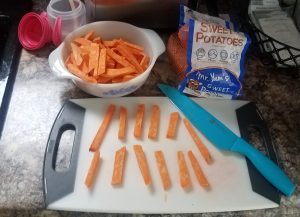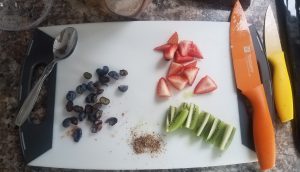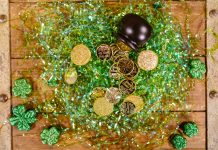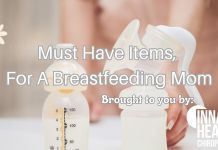 “What’s on the family menu tonight?”
“What’s on the family menu tonight?”
“Cheese tortellini and Italian-style meatballs.”
But what about my 8-month-old? Surely she can’t eat pasta and whole meatballs without them being pureed, right?
Au Contraire, my friend. While baby food has traditionally been pureed, baby-led weaning has gained quite a positive reputation over the last decade.
So what is it, exactly? Simply put, baby-led weaning is a style of food introduction that allows your child to feed themselves right from their first solid food experience.
The trend first gained popularity in the UK after the publication of Gill Rapley’s book of the same title. However, the concept of baby-led weaning has been around in different cultures for centuries.
But How?
I asked myself this question for months before deciding this was what we wanted to do with our second child. It didn’t seem plausible for an infant to eat entire pieces of food without any help. But here’s the thing, babies are so much stronger (and smarter, too) than we give them credit for.
I was worried Holly wouldn’t be able to properly chew foods without teeth. Oh, boy, did she prove me wrong! This girl has powered through egg rolls, meatballs, cucumber, and countless other impossible foods with not a tooth in sight.
BLW Best Practices
With that being said, there’s a correct way to go about the process of BLW. After all, you can’t really expect a 6-month-old to eat an entire meal when their tummies are a mere fraction the size of ours.
It’s Not What You Think
The first thing any prospective BLW parent should know is that while the name mentions “weaning,” it doesn’t mean you’re completely replacing breastmilk or formula with food. In this case, weaning means adding complementary foods to their diet of primarily breastmilk or formula.
This means you don’t need to worry about whether or not your little one is eating a proper amount. You do, however, still need to supervise them while they explore these new tastes and textures.
When to Start
Regardless of whether or not you choose baby-led or traditional weaning, it isn’t recommended to start solids until your little one is at least 6 months old. Introducing solid food too early can increase choking risk and cause obesity or other health problems.
Your baby is likely ready to start solids when (source):
- They’re at least 6 months old.
- They can sit unassisted for at least one minute.
- They no longer have their tongue-thrust reflex.
- They’re working on their pincer grip (grabbing things between the finger and thumb).
Proper Preparation
In order to have a successful BLW journey, it’s important to know how to prepare your baby’s food properly. Foods should be cooked thoroughly and cut into long, thick strips, especially in the beginning. Here’s a good example to go off:

- Blueberries, grapes, tomatoes, and other “oval-shaped” or awkwardly-shaped foods should be cut into halves or quarters to prevent choking. Berries can also be smashed and then given as well.

Pro tip: Use flax or chia seeds to help make gripping slimy foods easier.
Introducing Potential Allergens
An extremely common and totally valid concern is feeding when it comes to potential allergens. It used to be that you should wait to introduce peanuts, eggs, and other common “problem foods” until babies are older. However, the AAP now recommends introducing these foods early and often (source).
This is especially true for any child who is considered “at-risk” for an allergy. A child is considered “at-risk” if they have a family history of food allergies, suffer from eczema, or have an established egg allergy already.
What to Avoid
As exciting as this experience can be, there are still some things to be wary of. Just like with traditional weaning, there are certain foods that should be avoided when starting out.
- Honey: While it’s very uncommon, honey can cause infant botulism. Babies shouldn’t consume any honey or honey products until they’re at least 12 months old (source).
- Chips and other “hard” snacks: Popcorn, chips, nuts, and other “hard” snacks are a choking hazard. These foods aren’t recommended for any child under the age of 5.
- Peanut butter: The sticky consistency of peanut butter can cause an infant to choke. While you don’t necessarily need to avoid it, I recommend thinning it out with a little bit of water beforehand.
- High-sodium foods: Just like you wouldn’t yourself, your baby shouldn’t have an excess of sodium in their diet. This can lead to a number of health issues.
It’s also important to follow your baby’s own cues and not force them to eat. The entire premise of baby-led weaning is to let them learn to self-feed so they can tell when they’re full. You should also bear in mind that every child is different and they may not take well to this method.
Which is better?
It’s extremely common that I get asked which feeding method I believe is better between traditional and baby-led weaning. In no way am I a professional but as a parent who has done both methods, I’m confident in saying that neither one is better than the other. Like I mentioned above, every child is different, and depending on their cues, one method will work better than another.
Both methods teach the same skill, just in a different way. It all boils down to what feels easier for you and your child. When I look back on introducing foods with my first, I vividly remember absolutely dreading mealtimes. It was draining to have to stop everything to sit down and feed spoonful by spoonful.
Some parents may prefer this way, and that’s okay. Again, it all boils down to what works best for you and your child.

Pro Tips From a Mama Who’s Been There
Whenever people ask me about baby-led weaning, the one thing I mention every time is to relax. It’s so easy to start panicking when you see your baby gag or choke. Gagging is a completely normal and natural reflex. It’s smart to know the differences between gagging and choking so you can tell when it’s time to step in and help (source).
Gagging:
- It’s extremely common. The gag reflex in babies is much further forward in the mouth when they first start eating. As they learn, their gag reflex will travel further back into their throat.
- It’s noisy. When your baby is gagging, they may cough, gurgle, or even throw up. Rest assured, throwing up is completely normal (albeit, gross).
Choking:
- Choking is a much less common occurrence.
- It’s normally silent, but your baby may make high-pitched noises while trying to breathe.
- IF CHOKING OCCURS: intervene immediately. DO NOT try to finger swipe the food out of their mouth as it can cause further obstruction. Alternate between chest thrusts and back blows to dislodge the food. If your baby loses consciousness, perform CPR and call 911.
Pro Tip: If baby-led weaning interests you, consider taking an infant/child CPR class. Even if you’re already certified, it can be helpful to get a quick refresher course. This way, you can be prepared if something happens.
Our Household BLW staples
Some families prefer to make special food for their “weenie,” but we take a very relaxed approach here. Holly will get the same dinner everyone else gets, just cut and modified to be age/stage appropriate for her.
With that being said, there are a few staple pieces we keep on hand for lunches and snacks throughout the day. We do 95% of our shopping at Aldi, but you can definitely find these, or something similar, at just about any grocery store.
- Sweet Potato Bites: I like making these fresh, but I definitely don’t have time or patience to do it all the time. Aldi has dinosaur and other fun-shaped bites in their freezer section that can be made in less than 15 minutes.
- Green Pea Crisps: These are really nice for throwing in the diaper bag. They come in a small bag but last quite a while. We like to use these when we’re out and about to keep Holly’s hands (and mouth) occupied.
- Fresh Produce: I always keep fresh fruits and veggies stocked in general, but even more so now that Holly is eating solid food. We’re partial to avocado, mango, orange, and banana, but you can certainly tweak to your family preference.
- Hard-Boiled Eggs: Nothing comes between this girl and hard-boiled eggs…. NOTHING.
Quick and Easy Recipes
I don’t normally make anything specific for my daughter, but there are a few recipes that are always a success with us.
- Baby Pancakes: We received some baby food pouches for Christmas and I wasn’t sure how to use them at first. One day, I squeezed one into a bowl of pancake batter and the rest is history. Be careful doing this with a premade mix, though. Some pancake mixes have lots of added sugar and other ingredients.
- Roasted Chick Peas: The link provided is the one I use to make them for myself. When I want to make some for Holly, I cut off 5-7 minutes from the cooking time and go easy on the oil. Doing this keeps the chickpeas from getting too crispy for a baby to chew.
- Egg Muffins: These are a staple for our entire family and they’re super easy to make. You can get creative with them, but the main ingredients are tater tots (the base), egg, and cheese. You’ll have to bake the tater tots for a few minutes first to soften them up, then you add your eggs and other toppings before baking to finish. If you choose to use cheese, I recommend waiting to add it in until close to the end to prevent burning.
Raising a Foodie
Our experience with baby-led weaning thus far has been extremely positive. As I write this, I can’t help but compare to the feeding experience with our first. It seems that Holly is more open to trying new foods than her sister was and I sincerely hope that she keeps this up.
She’s truly a girl after my own foodie heart.












